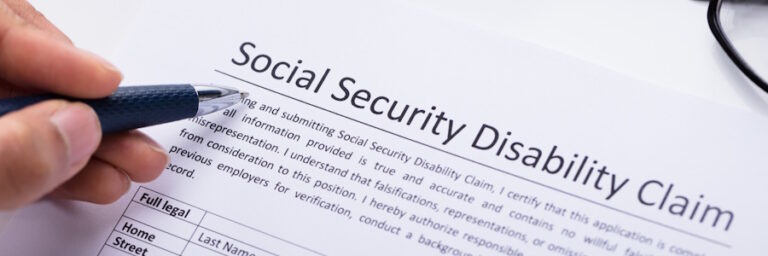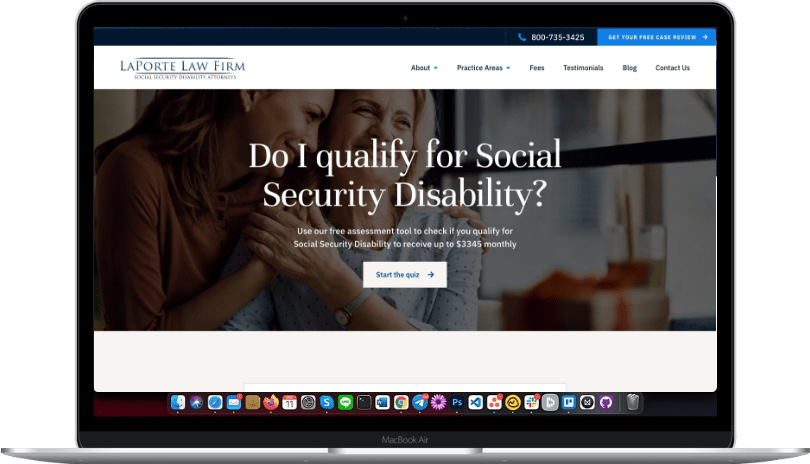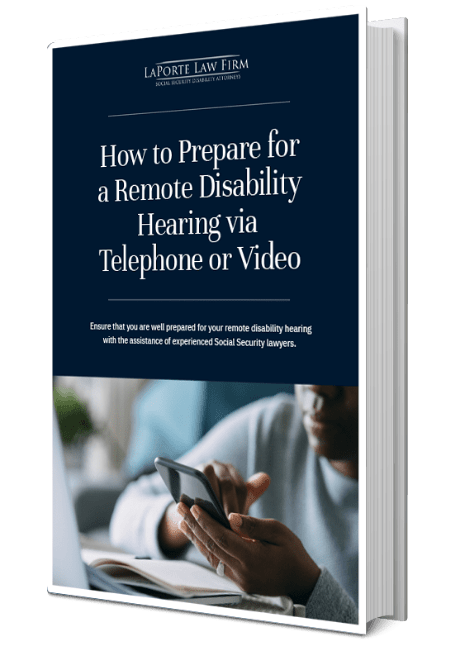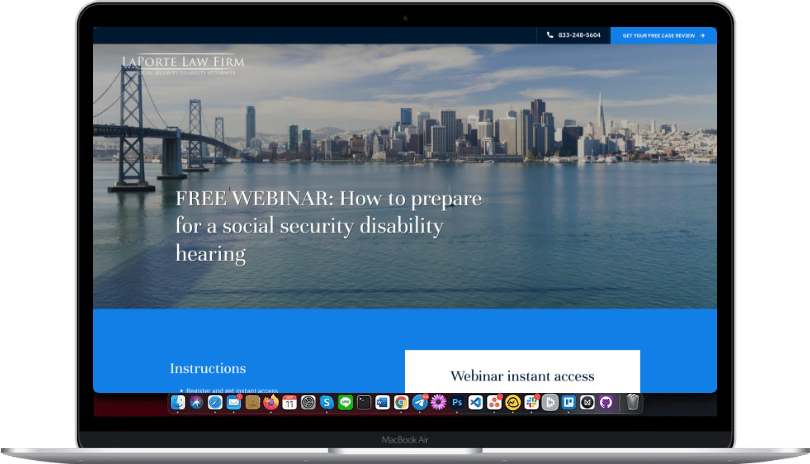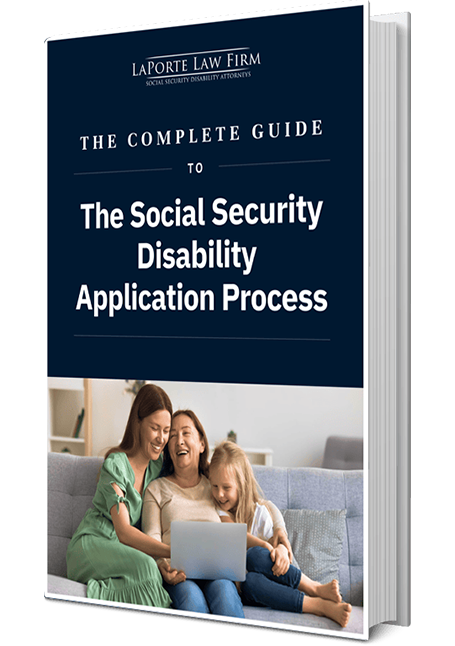
Since March 2020, or the outset of the COVID-19 pandemic, Social Security disability hearing offices (OHO) have offered remote hearing options via telephone or video teleconferencing. Prior to this, the vast majority of disability hearings were conducted in-person with a local Social Security administrative law judge (ALJ) at a local OHO. However, due to the safety concerns with conducting in-person hearings in the context of COVID-19, the local hearing offices pivoted to allowing disability claimants to opt for a phone or video hearing in lieu of an in-person hearing.
This shift necessitated ALJs, claimants, and attorneys to change the practices they were accustomed to and get used to a new reality. Initially, there were concerns about disability claimants’ due process right to an in-person hearing regarding the issue of their disability. There were also concerns that remote hearings were inferior to the more personal nature of in-person hearings. However, those concerns had to be balanced with the need to maintain public safety in the face of a contagious novel virus, especially with the vulnerable disabled population, and the need to process claims for disability that had already waited for years for an adjudication by an ALJ at the outset of the pandemic.
How Remote Disability Hearings Can Help
Remote disability hearings have proven to be successful, in that they have enabled claimants to enjoy the following benefits:
Reduced wait times
Social Security Disability Insurance (SSDI) claimants who agreed to a remote hearing during the pandemic had their cases adjudicated in 2020. Those who were approved after their remote hearing received their disability benefits as early as the second quarter of 2020. In contrast, those who did not waive their right to an in-person hearing experienced delays in the decision on their case for up to two years, since the ALJs did not return to in-person hearings until the third quarter of 2021.
In many cases, ALJs are still conducting the vast majority of cases via telephone or video conferencing software. ALJs have adapted to the new normal of conducting remote hearings by offering in-person hearings only one business day per week while working the rest of the week from home or their private office at the local OHO. This allows the ALJs to adjudicate cases that are already ready for a decision, meaning that all the relevant medical records have been submitted and the record is complete.
Impartiality in Remote Disability Hearings: Upholding the Integrity of ALJ Decisions
While disability hearings conducted via telephone or video may lack the personal touch of an in-person hearing, it is crucial to understand that the laws governing these remote hearings are identical to those applied in traditional settings. The Social Security Administration (SSA) has established clear guidelines to ensure fairness and impartiality in all disability hearings, regardless of the format. One key principle enshrined in these regulations is the prohibition against Administrative Law Judges (ALJs) “playing doctor” from the bench.
This principle ensures that ALJs cannot base their decisions on subjective observations of a claimant’s appearance, demeanor, or behavior during the hearing. Instead, decisions must be rooted in the medical evidence presented and the applicable legal standards. This safeguard is particularly important in remote hearings, where the nuances of body language and facial expressions may be more difficult to discern or may be influenced by the technology being used.
Historically, many unfavorable disability claims have been reversed on appeal due to ALJs improperly making inferences about a claimant’s ability to work based on their observations during the hearing. For example, an ALJ cannot assume that a claimant’s ability to sit through a one-hour hearing without shifting positions undermines their testimony regarding an inability to sit for extended periods. Such inferences ignore the complexities of medical conditions and the fact that brief observations during a hearing do not capture the full extent of a claimant’s daily struggles.
In remote hearings, where the interaction between ALJ and claimant is mediated by technology, it is even more critical that decisions remain grounded in the documented medical evidence and legal criteria, rather than personal observations. The SSA’s commitment to this principle ensures that all claimants receive a fair hearing, free from bias, whether their case is heard in person, over the phone, or via video conference.
This emphasis on impartiality protects the integrity of the disability determination process and upholds the rights of claimants, ensuring that each decision is based on the facts of the case rather than subjective impressions.
Increased judge availability
As mentioned, some ALJs are conducting in-person hearings only one day per week, and reserving the rest of the weekdays to conduct remote hearings and write decisions. This can result in backlogs for those disability claimants who elect to have their hearing in person but works in favor of those who choose remote hearings.
In addition, the availability of remote hearings has allowed Social Security hearing offices to reduce case backlogs by transferring hearing requests to different offices around the country, further reducing the wait times for those with pending cases.
It should be noted that wait times vary at every hearing office, so if you are pending at the hearing level or have recently been denied at the request for reconsideration level, you should consult a local attorney who can advise you regarding the current average wait times at your local office, as well as the risks and benefits of agreeing to a remote hearing.
Reduced travel costs and time commitment
There are also phantom costs associated with undergoing in-person hearings. Most hearing offices are located in downtown urban areas with limited parking. For example, the hearing offices in downtown Oakland and the financial district in San Francisco have expensive on-street and garage parking. The most convenient garage parking closest to the hearing offices can charge between $10 and $30 dollars. If your hearing is scheduled for the morning, you must also account for rush-hour traffic, which can double your commute time on a day that does not need any added stress.
Prior to the pandemic, it was advisable to conduct a “practice run” in which a disability claimant travels to the hearing office on the exact day of the week and time of their upcoming disability hearing, just to experience firsthand the likely traffic patterns and other variables of the commute on the day of their hearing. With phone and video hearings, disability claimants do not need to worry about parking fees or traffic patterns, and can instead testify from the comfort of their home.
Increased accessibility
Remote hearings also allow disability claimants who struggle with ambulation or need assistance leaving the home to access justice easier. Some disability claimants require prior preparation or third-party assistance just so they can leave the house. For those whose medical condition causes “good days” and “bad days,” the ability to travel to the hearing and navigate a federal building is not guaranteed. In some cases before the availability of remote hearings, disability claimants suffered the unfortunate experience of having their hearing rescheduled because they could not travel to the hearing office due to a severe medical event. With remote hearings, these concerns are alleviated.
The Current Backlog and Wait Times for SSDI Hearings
Since the start of the pandemic, the number of claims for disability have declined, but the wait times are still increasing. The SSA attributes these delays to the 7% reduction in workforce, resulting in the lowest staffing levels in 25 years.
Compounding the backlog problems is the 25% attrition rate for Social Security employees, leading to the need to hire and train new employees to perform complex and important jobs. Because the rules governing Social Security are so complex, training for a typical employee can take over one year.
To illustrate how slow Social Security is getting, the average wait time for the SSA’s phone line is currently 36 minutes. The SSA is a massive agency that has a great impact on a large number of people, paying over $1.4 trillion in benefits to over 71 million people every year, so staff and budget cuts can have a significant impact on the American population and economy. Delays tend to compile, so longer wait times at the initial and reconsideration stages can have downline effects at the hearing stage. When Social Security clears a backlog at the reconsideration stage, those cases can pile up at the hearing offices. Some hearing offices that cut their backlogs with remote hearings were assigned additional cases from out-of-state areas. Therefore, the hearing office backlog situation is incredibly fluid.
The average wait times at the hearing level vary by location. “Wait time” is defined as the amount of time the average disability claimant waits from the date of the hearing request and the date of adjudication. These are the current average wait times as of June 2024 according to Social Security’s publicly available data.
- San Rafael – 8 months
- Stockton – 9 months
- San Francisco – 11 months
- Oakland – 11 months
- Fresno – 12 months
- San Jose – 12 months
- Sacramento – 13 months
To find out the current average wait time at your local Social Security hearing office, consult the SSA website and find your nearest OHO location.
Is a Remote Disability Hearing Right for You?
As with all frustrating legal advice, the answer to the question of whether you should waive your right to an in-person hearing and elect to use one of the remote hearing options is “it depends.” This is an unsatisfying answer, but it applies to the uniquely complex world of Social Security disability hearings. In some cases, there is an extremely good reason to refuse the remote hearing options provided by SSA hearing offices.
While in-person hearings can be beneficial for some, remote hearings offer advantages for others. Factors such as the following should be considered when deciding:
Ability to present your case virtually
For example, if you have low hearing and benefit from in-person, face-to-face interactions to process verbal questions before formulating each response, you may prefer an in-person hearing to a remote hearing. Another example is a disability claimant who suffers from Parkinson’s disease that causes resting tremors in both hands. Although the judge is not a doctor and is not supposed to make a decision based on their observations of a disability claimant during the in-person hearing, actually seeing the constant shaking of the claimant’s hands during testimony provides context that a telephone hearing, or a video hearing in which the claimant’s hands are not visible, would not be able to offer.
As you can see, each case is specific to a disability claimant’s impairments and background. It is a good idea to consult a disability attorney who is experienced with both in-person and remote hearings to discuss which option is best for your case.
Comfort level with technology
When deciding if a remote hearing is best for you, consider which piece of technology you are more comfortable using. For example, if you do not have experience with video conferencing software such as Zoom, you may consider electing a telephone hearing instead. Also, if you do not have access to high-speed Wi-Fi with the bandwidth required to support a video call without interruptions or lagging, you might opt for a telephone hearing.
Similarly, if you live in a remote area with unreliable cell service, consider going to a location with better service on the day of your remote hearing. Alternatively, you can elect to undergo an in-person hearing, taking into account the issue of travel time and potential increased wait times discussed above.
Complexity of your disability case
Some claims for disability have complex procedural or medical issues. Depending on the issue, there may be a good reason to opt for an in-person hearing rather than a remote hearing. However, it should be noted that, regardless of the type of hearing you select, the ALJ deciding your case will have the same record to review for the decision. ALJs have electronic access to a disability claimant’s file, which is the documentary record they review while listening to testimony. This record is the same regardless of the type of hearing.
Consultation with your representative or the SSA
If you are deciding which type of hearing to elect, you should consult with your disability attorney. You should also ensure that you have signed and completed your election via the SSA’s Remote Hearing Agreement Form at the earliest possible opportunity. This avoids delays with the scheduling of your hearing since some hearing offices will not schedule a hearing until they receive confirmation that you agree to a remote hearing option.
What to Expect During Your Remote Disability Hearing
While the format of remote hearings may differ from in-person hearings, the process and legal standards remain the same. Claimants can expect the following during their remote disability hearing:
Format of a remote Hearing
You should be prepared up to 45 minutes before your scheduled hearing, in case the ALJ wants to start the hearing early. For video hearings, familiarize yourself with the Microsoft Teams teleconferencing software well before the hearing. Before the hearing, the OHO will send you a link via email containing the log in for the hearing.
You can expect a similar structure to in-person hearings, including:
- Introductions
The ALJ will begin the hearing process by introducing themselves and the other people on the call, such as your representative (if applicable), the hearing reporter, the vocational expert, and the medical expert (if applicable). The ALJ will confirm with you on the record that you still agree to conducting the hearing by telephone or video conference, that you are not recording the hearing (the SSA recording is the only official recording of the hearing), and that you are alone in a private room, and will let the ALJ know if anyone enters the room where you are testifying.
- Opening statements
Some ALJs permit the attorney representative to make a brief opening statement, highlighting the strongest evidence in the record and presenting a legal theory of the case as to why your claim should be approved.
- Direct Examination
Some ALJs will do most of the questioning on direct examination, while others require the attorney representative to pose all of the questions on direct examination. If a medical expert is testifying, their testimony usually takes place first, and the ALJ will pose direct questions to the medical expert before allowing the attorney to pose questions on cross examination. Similarly, the ALJ will pose direct questions to the vocational expert at the end of the hearing before allowing the attorney to cross examine the vocational expert.
- Closing statements
At the close of the hearing, some ALJs permit the attorney to present a closing statement, highlighting how the expert’s and claimant’s testimonies support the legal theory of the case.
Importance of clear communication
It’s important to clearly communicate with the ALJ, regardless of which type of hearing you elect. This includes maintaining polite and honest communication with the ALJ, waiting until the ALJ has finished each question before beginning your answer, etc. For more advice on how to present your case at your remote hearing, consult our blog post about preparing for your hearing via telephone or video conference.
Preparing for Your Remote Disability Hearing
Proper preparation is key to increasing your chances of a successful outcome. Here are some of the things you should do before your remote disability hearing:
Make sure you have a reliable internet connection and working device
Ensure your device (computer, phone) is in good working order with a stable internet connection to avoid technical disruptions. Your attorney will conduct pre-hearing preparation sessions with you prior to the hearing, which is a good time to test your device for audio/video quality and to formulate a plan for where you will testify on the day of your hearing.
Select a quiet, private location
Choose a place where you won’t be disturbed by family members or pets, ensuring privacy and the ability to focus on the hearing. If you have young children, ask a friend or family member to help watch them during the hearing. If you do not have access to a private area in your home that is out of earshot from others, consider testifying from inside of a private vehicle. However, be sure that the vehicle is parked in a safe area that is away from road noise.
Gather the necessary documents
All medical and other evidence must be submitted to the ALJ more than five days before the hearing. At the hearing, you should focus on your testimony rather than the evidence before the ALJ. If needed, you can refer to a list of your medications and a brief timeline of your work history and disability during the hearing. However, most ALJs want to hear unprepared and spontaneous testimony, rather than overly prepared remarks. This is especially true if you are represented by an attorney. If your testimony appears too rehearsed or prepared, the ALJ may question whether your testimony is truly your own.
Seek assistance from representatives or advocacy organizations
You should consult a trained disability attorney to discuss your unique case, your options for in-person, phone, or video hearings, and how to testify before the ALJ. Disability attorneys offer free consultations to discuss your case, and if offered representation, you do not pay out of pocket. Attorney’s fees in disability cases are contingent on the approval by the ALJ. An attorney can help you meet all deadlines, obtain and submit medical and other supporting evidence for your case, and prepare to testify before the ALJ at your hearing.
If you need assistance with your disability claim, look no further than LaPorte Law Firm. We have a proven track record of success in handling SSDI cases, and our legal professionals have the expertise and experience to navigate the intricacies of the claims and appeals process. Reach out to us today for a free consultation.
FAQs
Social Security does not produce publicly available statistics regarding the differences in wait times between in-person hearings and remote hearings. Anecdotally, those who elected to have a remote disability hearing were scheduled more quickly than those who elected an in-person hearing.
Remote hearings are less personal. Also, remote hearings run the risk of delays due to technical difficulties due to poor video quality or bad cell service on the part of the disability claimant, representative, or ALJ. However, as the hearing offices now have over four years of experience conducting remote hearings, technical delays are increasingly rare.
Learn more about preparing for remote disability hearings by reading our blog post about this topic.
In most cases, no one can be present during your testimony, including close family members. The ALJ wants to hear your testimony in your own words. The ALJs do not want any friends or family members to influence or assist with your testimony.





